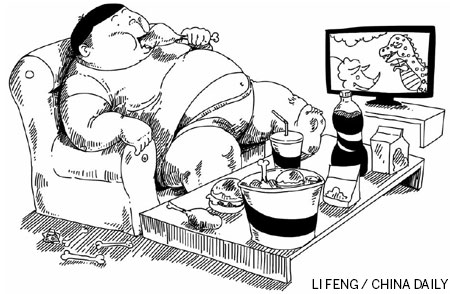Child's obesity is outpacing growth
Updated: 2013-05-30 08:22
By Cesar Chelala (China Daily)
|
||||||||

Obesity in China, particularly among children, has become a growing health concern that will not only seriously affect the health of future generations but also place a heavy economic burden on the country. In 1982, only 7 percent of the population was obese, now, according to the World Health Organization, more than 38 percent of Chinese above the age of 15 are overweight.
To make the situation even more serious, China - as well as Vietnam, India, and many other developing countries - has to shoulder a "double burden": the persistence of undernutrition, particularly among children in rural areas, and a rapid rise in obesity and overweight-related diseases such as cardiovascular disease, hypertension and strokes, type II diabetes and certain forms of cancer.
Although the terms obese and overweight are sometimes used interchangeably, they have different meanings. The body mass index is used to determine body fat based on a person's weight and height. A healthy BMI is considered to be between 18.5 to 25. A person with a BMI between 25 and 30 is considered overweight, while a person whose BMI is more than 30 is considered obese. Morbid obesity refers to someone with a BMI of 40 or more.
Overweight is not only a problem in developing countries alone; it is a problem worldwide. In the United States, the number of overweight children has doubled and the number of overweight adolescents tripled since 1980, according to the US Surgeon General.
In Chinese cities, according to official statistics, 15 percent of children aged 10 to 12 are considered overweight and an additional 8 percent are obese. A University of Southern California study carried out in 2006 found that the average body fat of Hong Kong children was 21 percent, which is extremely high.

 Michelle lays roses at site along Berlin Wall
Michelle lays roses at site along Berlin Wall
 Historic space lecture in Tiangong-1 commences
Historic space lecture in Tiangong-1 commences
 'Sopranos' Star James Gandolfini dead at 51
'Sopranos' Star James Gandolfini dead at 51
 UN: Number of refugees hits 18-year high
UN: Number of refugees hits 18-year high
 Slide: Jet exercises from aircraft carrier
Slide: Jet exercises from aircraft carrier
 Talks establish fishery hotline
Talks establish fishery hotline
 Foreign buyers eye Chinese drones
Foreign buyers eye Chinese drones
 UN chief hails China's peacekeepers
UN chief hails China's peacekeepers
Most Viewed
Editor's Picks

|

|

|

|

|

|
Today's Top News
Shenzhou X astronaut gives lecture today
US told to reassess duties on Chinese paper
Chinese seek greater share of satellite market
Russia rejects Obama's nuke cut proposal
US immigration bill sees Senate breakthrough
Brazilian cities revoke fare hikes
Moody's warns on China's local govt debt
Air quality in major cities drops in May
US Weekly

|

|








